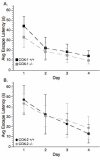Effects of genetic deficiency of cyclooxygenase-1 or cyclooxygenase-2 on functional and histological outcomes following traumatic brain injury in mice
- PMID: 19719848
- PMCID: PMC2751761
- DOI: 10.1186/1471-2202-10-108
Effects of genetic deficiency of cyclooxygenase-1 or cyclooxygenase-2 on functional and histological outcomes following traumatic brain injury in mice
Abstract
Background: Neuroinflammation contributes to the pathophysiology of acute CNS injury, including traumatic brain injury (TBI). Although prostaglandin lipid mediators of inflammation contribute to a variety of inflammatory responses, their importance in neuroinflammation is not clear. There are conflicting reports as to the efficacy of inhibiting the enzymes required for prostaglandin formation, cyclooxygenase (COX) -1 and COX-2, for improving outcomes following TBI. The purpose of the current study was to determine the role of the COX isoforms in contributing to pathological processes resulting from TBI by utilizing mice deficient in COX-1 or COX-2.
Results: Following a mild controlled cortical impact injury, the amount of cortical tissue loss, the level of microglial activation, and the capacity for functional recovery was compared between COX-1-deficient mice or COX-2-deficient mice, and their matching wild-type controls. The deficiency of COX-2 resulted in a minor (6%), although statistically significant, increase in the sparing of cortical tissue following TBI. The deficiency of COX-1 resulted in no detectable effect on cortical tissue loss following TBI. As determined by 3[H]-PK11195 autoradiography, TBI produced a similar increase in microglial activation in multiple brain regions of both COX-1 wild-type and COX-1-deficient mice. In COX-2 wild-type and COX-2-deficient mice, TBI increased 3[H]-PK11195 binding in all brain regions that were analyzed. Following injury, 3[H]-PK11195 binding in the dentate gyrus and CA1 region of the hippocampus was greater in COX-2-deficient mice, as compared to COX-2 wild-type mice. Cognitive assessment was performed in the wild-type, COX-1-deficient and COX-2-deficient mice following 4 days of recovery from TBI. There was no significant cognitive effect that resulted from the deficiency of either COX-1 or COX-2, as determined by acquisition and spatial memory retention testing in a Morris water maze.
Conclusion: These findings suggest that the deficiency of neither COX-1 nor COX-2 is sufficient to alter cognitive outcomes following TBI in mice.
Figures




References
Publication types
MeSH terms
Substances
Grants and funding
LinkOut - more resources
Full Text Sources
Research Materials
Miscellaneous

